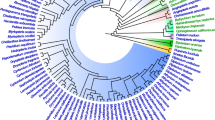Abstract
Nucleotide sequences of the self-splicing group-II intron of rps16 have first been determined in nine species of the Solanum genus. It was found that the observed variations in the intron length (855–864 bp) was associated with indels of 1 to 9 bp. Altogether, five indels and 50 nucleotide substitutions were detected, which were used to identify six Solanum haplotypes. Although the intron sequence was in general fairly well conserved, the distribution of the described mutations among its structural elements corresponding to six pre-RNA domains was qualitatively and quantitatively nonuniform. The highest polymorphism levels were observed in domains I, II, and IV. The sequence of domain V was absolutely invariable, which is in agreement with its functional significance. The chloroplast rpS16 intron sequences have been characterized in nine Solanum species. The intron length ranged from 855 bp to 864 bp, which is associated with 1–9-nucleotide indels. In total five indels and 50 nucleotide substitutions have been detected and six Solanum haplotypes have been revealed. Solanum rpS16 introns has been characterized by mutation rate heterogeneity between structure regions of all six domains its pre-RNA. Intron domains I, II, IV are shown to be more variable. Sequences of the domain V are invariant, that agrees with its functional significance.
Similar content being viewed by others
References
Michel, F., Umesono, K., and Ozeki, H., Comparative and functional anatomy of group II catalytic introns-a review, Gene, 1989, vol. 82, pp. 5–30.
Toor, N., Hausner, G., and Zimmerly, S., Coevolution of group II intron RNA structures with their intron-encoded reverse transcriptases, RNA, 2001, vol. 7, pp. 1142–1152.
Marcia, M. and Pyle, A.M., Visualizing group II intron catalysis through the stages of splicing, Cell, 2012, vol. 151, no. 3, pp. 497–507.
Kelchner, S.A., Group II introns as phylogenetic tools: Structure, function and evolutionary constraints, Am. J. Bot., 2002, vol. 89, pp. 1651–1669.
Lencastre, A. and Pyle, A.M., Three essential and conserved regions of the group II intron are proximal to the 59-splice site, RNA, 2008, vol. 14, pp. 11–24.
Fedorova, O. and Pyle, A.M., A conserved element that stabilizes the group II intron active site, RNA, 2008, vol. 14, pp. 1048–1056.
Michel, F., Costa, M., and Westhof, E., The ribozyme core of group II introns: a structure in want of partners, Trends Biochem. Sci., 2009, vol. 34, no. 4, pp. 189–199.
Hausner, G., Olson, R., Simon, D., et al., Origin and evolution of the chloroplast trnK (matK) intron: a model for evolution of group II intron RNA structures, Mol. Biol. Evol., 2006, vol. 23, pp. 380–391.
Ryzhova, N.N., Kholda, O.A., and Kochieva, E.Z., Structural characteristics of the chloroplast rps16 intron in Allium sativum and related Allium species, Mol. Biol. (Moscow), 2009, vol. 43, no. 5, pp. 766–775.
Downie, S.R. and Palmer, J.D., Use of chloroplast DNA rearrangements in reconstructing plant phylogeny, Molecular Systematics of Plants, Soltis, D.E., Ed., New York: Chapman and Hall, 1992, pp. 14–35.
Doyle, J.J., Doyle, J.L., and Palmer, J.D., Multiple independent losses of two genes and one intron from legume chloroplast genomes, Syst. Bot., 1995, vol. 20, pp. 272–294.
Oxelman, B., Liden, M., and Berglund, D., Chloroplast rps16 intron phylogeny of the tribe Sileneae (Caryophyllaceae), Plant Syst. Evol., 1997, vol. 206, pp. 393–410.
Popp, M. and Oxelman, B., Inferring the history of the polyploid Silene aegaea (Caryophyllaceae) using plastid and homoeologous nuclear DNA sequences, Mol. Phylogenet. Evol., 2001, vol. 20, pp. 474–481.
Lee, J. and Hymowitz, T., A molecular phylogenetic study of the subtribe Glycininae (Leguminosae) derived from the chloroplast DNA rps16 intron sequences, Am. J. Bot., 2001, vol. 88, pp. 2064–2073.
Groppo, M., Pirani, J.R., Salatino, M.L.F., et al., Phylogeny of Rutaceae based on two noncoding regions from cpDNA, Am. J. Bot., 2008, vol. 95, no. 8, pp. 985–1005.
Hong, S.W.-P. and Jury, S.L., Phylogeny and divergence times inferred from rps16 sequence data analyses for Tricyrtis (Liliaceae), an endemic genus of North-East Asia, AoB PLANTS, 2011. doi:10.1093/aobpla/plr025, www.aobplants.oxfordjournals.org
Shaw, J., Lickey, E.B., Beck, J.T., et al., The tortoise and the hare II: relative utility of 21 noncoding chloroplast DNA sequences for phylogenetic analysis, Am. J. Bot., 2005, vol. 92, pp. 142–166.
Kumar, S., Tamura, K., and Nei, M., MEGA3: Integrated software for molecular evolutionary genetics analysis and sequence alignment, Brief. Bioinform., 2004, vol. 5, pp. 150–163.
Zuker, M., Mfold web server for nucleic acid folding and hybridization prediction, Nucleic Acids Res., 2003, vol. 31, pp. 3406–3415.
Author information
Authors and Affiliations
Corresponding author
Additional information
Original Russian Text © N.N. Ryzhova, M.A. Slugina, E.Z. Kochieva, K.G. Skryabin, 2013, published in Genetika, 2013, Vol. 49, No. 7, pp. 824–829.
Rights and permissions
About this article
Cite this article
Ryzhova, N.N., Slugina, M.A., Kochieva, E.Z. et al. Polymorphism and structural variation of rps16 group-II intron in the Solanum species. Russ J Genet 49, 717–721 (2013). https://doi.org/10.1134/S1022795413070120
Received:
Published:
Issue Date:
DOI: https://doi.org/10.1134/S1022795413070120




